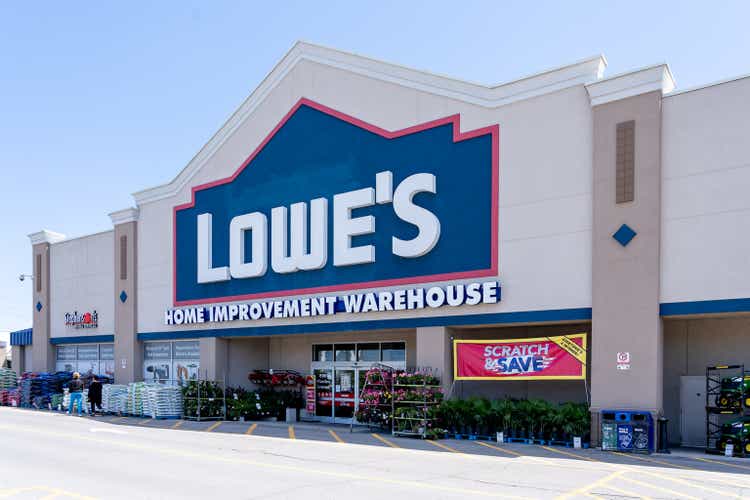
JHVEPhoto
JHVEPhoto
It’s better to buy dividend aristocrats when they are trading down in the dumps versus when the market loves them. That’s because getting an attractive starting yield and valuation are crucially important to garnering market-beating returns over the long haul.
In the words of Buffett: “Price is what you pay, and value is what you get”, which I interpret to mean that paying a higher price for a stock doesn’t necessarily mean that the stock is any better than getting it at a bargain price, especially if the long-term thesis isn’t broken.
This brings me to Lowe’s (NYSE:LOW), which remains in value territory, especially considering the quality of the enterprise. In this article, I highlight what makes this dividend aristocrat a solid buy at present, so let’s get started.
Lowe’s is the second-largest home improvement retailer in the world, sitting behind Home Depot (HD), with nearly 2,000 stores in North America (U.S. and Canada). While retail ‘do it yourself’ customers account for the majority (75%) of its sales, it also does substantial business with commercial and professional clients, who account for the remaining quarter of sales.
Lowe’s stock has fallen substantially, with shares returning -25% since the start of the year. This is due primarily to LOW getting hit with a double-whammy, as inflation has pressured consumer spending, and rising rates have greatly slowed down the housing market. At the current price of $191.53, the stock trades well below its 52-week high of $263 achieved at the end of last year.
Nonetheless, Lowe’s maintains inherent strengths, due to its economy of scale and distribution capabilities. This enables it to edge out smaller competitors with higher cost structures, which puts them at a pricing disadvantage. Morningstar assigns LOW a wide economic moat due to the following factors in its recent analyst report:
As the second-largest global home improvement retailer, we believe Lowe’s will continue to gain incremental share in the North American home improvement retail segment (which Lowe’s has estimated at around a $900 billion market at the end of 2021), given its extensive distribution network and economies of scale as well as the brand awareness it has built with consumers and professionals.
Dissecting the components of its competitive prowess, Lowe’s has been able to capture economic rents from its brand, offering an important intangible asset. This is evidenced in consistent same-store sales growth, which has averaged 9% over the past five years (just 50 basis points below its peer Home Depot).
Admittedly, Lowe’s is feeling pressures in the current environment, as comparable sales decreased by 4% YoY in its fiscal first quarter (ended in April). However, it’s worth noting that this is on the back of a difficult comparable, due to heighted retail spending last year due to stay at home trends. On a two-year stacked basis, Lowe’s U.S. comparable sales actually increased by a respectable 19.7%.
Moreover, Lowe’s hasn’t had to sacrifice profitability, as it delivered over 65 basis points of operating margin improvement, driven by its Total Home strategy and the execution of its Perpetual Productivity Improvement initiatives. As shown below, Lowe’s scores an A+ profitability score, driven by its above average EBITDA margin and returns on capital.
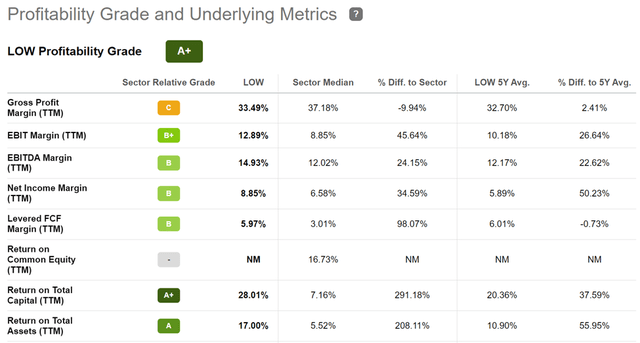
LOW Profitability (Seeking Alpha)
LOW Profitability (Seeking Alpha)
In addition, Lowe’s technically has negative shareholders’ equity. That’s not as bad as it sounds, because it’s a serial repurchaser of its stock. This is one of the advantages to being a mature company, as it no longer needs substantial growth capital to grow its store count and can therefore aggressively return capital to shareholders. As shown below, Lowe’s has retired 20.4% of its outstanding share count over the past 5 years alone.
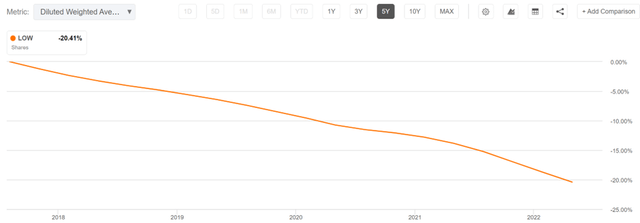
LOW Shares Outstanding (Seeking Alpha)
LOW Shares Outstanding (Seeking Alpha)
Looking forward, I believe the market may be overly pessimistic on the state of the retail consumer as the CEO of Bank of America (BAC) recently remarked on the strength of consumer savings. This sentiment was echoed by Lowe’s CEO during the recent conference call:
Despite some increased uncertainty in the macro environment, our long-term outlook for the home improvement industry remains positive. Homeowner balance sheets are very strong, and their confidence to purchase big-ticket items is supported by continuing home price appreciation. Other factors like the extension of remote work, the age of the housing stock, millennial household formation, and baby boomers’ preference to age in place, all are long-term tailwinds for home improvement.
Meanwhile, I don’t see Lowe’s letting go of its Dividend King status (59 years of consecutive raises) any time soon. While the dividend yield is just 2.2%, it comes with an impressive 18.8% 5-year CAGR and is well-protected by a low 26% payout ratio.
Lastly, Lowe’s maintains a strong BBB+ rated balance sheet appears to be reasonably cheap at the current price of $191.53 with a forward PE of 14.2, sitting well below its normal PE of 20.8 over the past decade. Sell side analysts have a consensus Buy rating on the stock, with an average price target of $238. This equates to a potential one-year 26% total return including dividends.
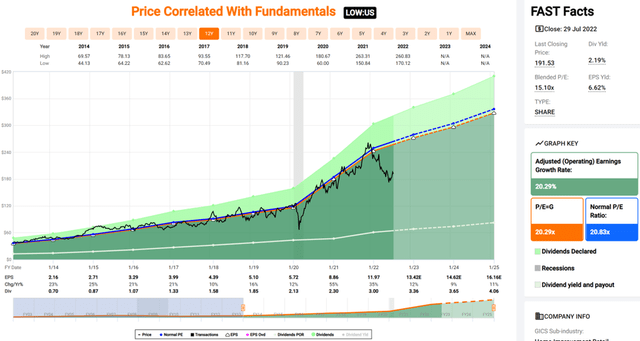
LOW Valuation (FAST Graphs)
LOW Valuation (FAST Graphs)
In summary, I believe Lowe’s is a high-quality business that’s trading in bargain territory. It has several key competitive advantages including its brand, economies of scale, and extensive distribution network. It’s aggressively returning capital to shareholders in the form of share buybacks and dividend bumps. While it’s seeing some near-term headwinds, I believe the long-term growth thesis is intact and the current valuation presents an attractive opportunity for long-term investors.
Gen Alpha has teamed up with Hoya Capital to launch the premier income-focused investing service on Seeking Alpha. Members receive complete early access to our articles along with exclusive income-focused model portfolios and a comprehensive suite of tools and models to help build sustainable portfolio income targeting premium dividend yields of up to 10%.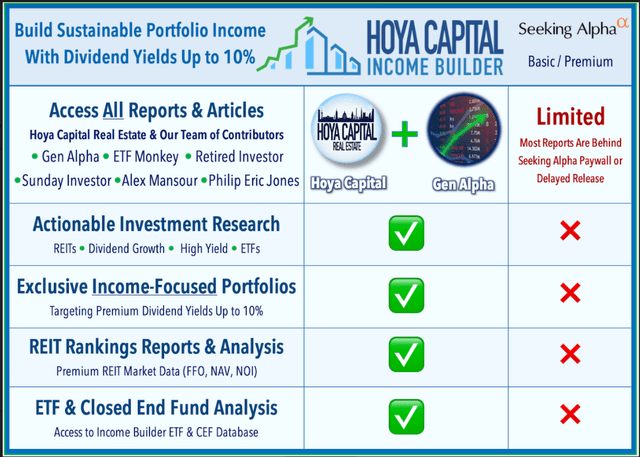
Whether your focus is High Yield or Dividend Growth, we’ve got you covered with actionable investment research focusing on real income-producing asset classes that offer potential diversification, monthly income, capital appreciation, and inflation hedging. Start A Free 2-Week Trial Today!
This article was written by
I’m a U.S. based financial writer with a BSc in Economics and an MBA in Finance. I have over 12 years of investment experience, and generally focus on stocks that are more defensive in nature, with a medium to long-term horizon. My goal is to share useful and insightful knowledge and analysis with readers. Contributing author for Hoya Capital Income Builder.
Disclosure: I/we have no stock, option or similar derivative position in any of the companies mentioned, and no plans to initiate any such positions within the next 72 hours. I wrote this article myself, and it expresses my own opinions. I am not receiving compensation for it (other than from Seeking Alpha). I have no business relationship with any company whose stock is mentioned in this article.
Additional disclosure: I am not an investment advisor. This article is for informational purposes and does not constitute as financial advice. Readers are encouraged and expected to perform due diligence and draw their own conclusions prior to making any investment decisions.